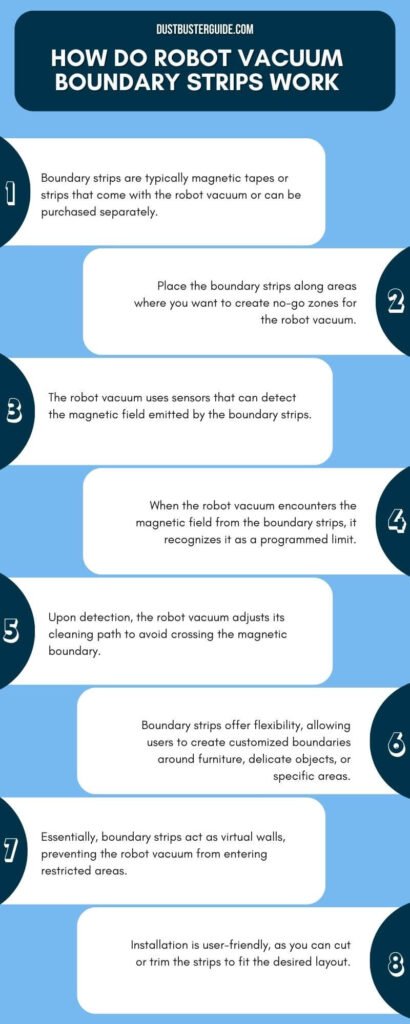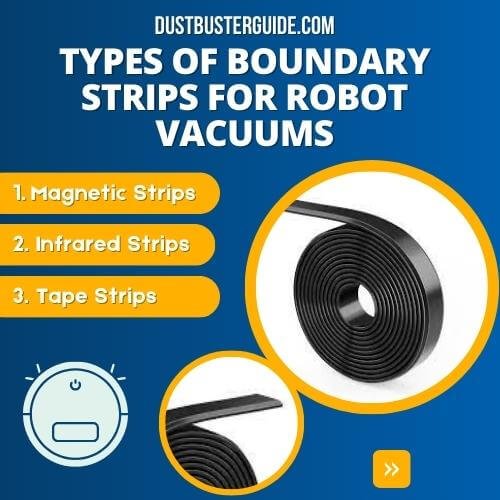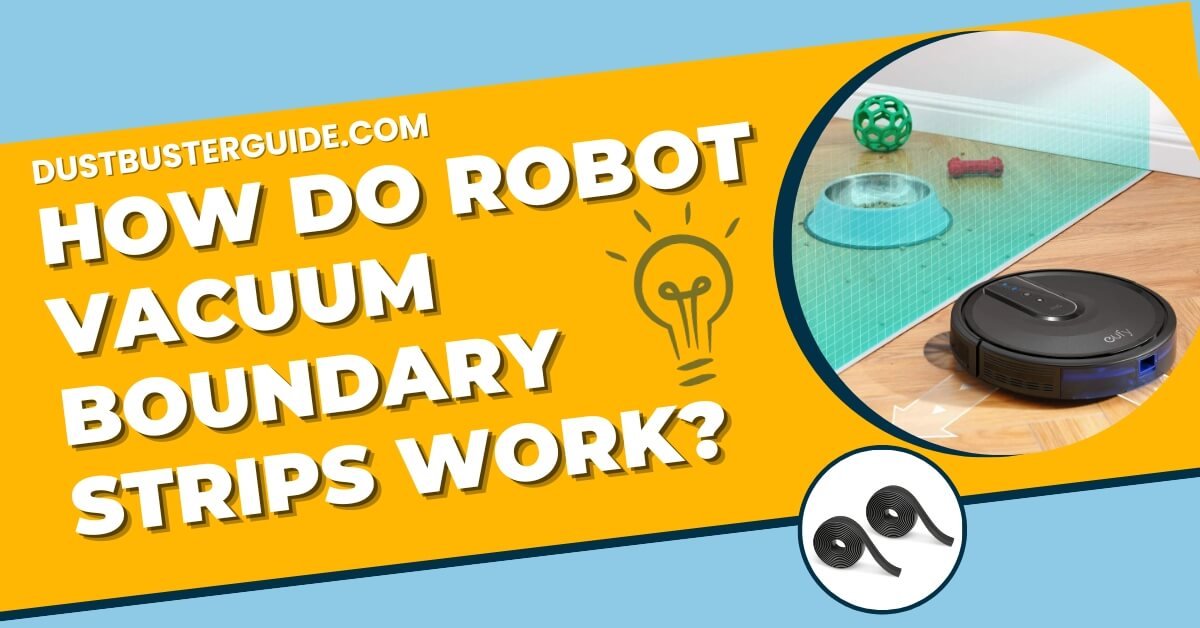The spatial choreography of your cleaning routine takes a boundary-setting turn: how do robot vacuum boundary strips work? It’s an exploration into the wizardry of setting limits for your cleaning companion.
Picture this: your diligent robot vacuum respecting invisible boundaries, and the question arises. In just a couple of lines, the answer glides in like a boundary strip revelation: These magnetic or infrared strips act as virtual walls, guiding your robot vacuum and preventing it from crossing designated boundaries.
But before you assume it’s a magical solution, join us on this exploration. We’ll delve into the mechanics of boundary strips, ensuring your cleaning companion respects the spatial choreography you set.
How Do Robot Vacuum Boundary Strips Work – Explained
Robot vacuum boundary strips work by creating invisible boundaries that your vacuum recognizes and respects. These strips are typically made of magnetic tape or infrared sensors that emit a signal indicating where the virtual barrier is.
When you set up the boundary strips, you can place them in areas where you don’t want your robot vacuum to enter. For example, if you have fragile objects or pet bowls that you don’t want the vacuum to disturb, you can place the strips around those areas.
The robot vacuum comes equipped with sensors that detect the signals emitted by the boundary strips. When it detects the signal, it knows that it should not cross the strip and respects the boundary you have set. This way, you can ensure that the vacuum only cleans the areas you want it to, avoiding any potential damage or disturbance.

How To Set Up And Use Robot Vacuum Boundary Strips
Setting up robot vacuum boundary strips is a simple process. Here’s a step-by-step guide to help you get started:
Once you have set up the boundary strips, you can start using your robot vacuum as usual. The vacuum will recognize the virtual boundaries, and you can let it roam freely without worrying about it entering unwanted areas.
What Are The Benefits Of Using Robot Vacuum Boundary Strips
Using robot vacuum boundary strips offers several benefits that can greatly enhance your cleaning routine. Here are a few advantages:
1. Flexibility and Control: Boundary strips provide you with the flexibility to choose which areas you want to clean and which areas you want to avoid. You have complete control over where the vacuum goes, ensuring it stays away from delicate objects or designated rooms.
2. Time and Energy Saving: By setting up virtual boundaries, you don’t have to spend time moving obstacles or closing doors to prevent the vacuum from entering certain areas. This saves you both time and energy, allowing you to focus on other tasks while the vacuum does its job.
3. Enhanced Cleaning Efficiency: With the ability to concentrate the cleaning in specific areas, you can ensure a more thorough and efficient cleaning process. The vacuum can spend more time in the areas that need it the most, resulting in cleaner floors overall.
4. Peace of Mind: Knowing that your robot vacuum will stay within the boundaries you have set gives you peace of mind. You can confidently let the vacuum clean while you attend to other chores or simply relax.
In conclusion, robot vacuum boundary strips are a game-changer when it comes to cleaning your floors efficiently and effortlessly. By creating virtual barriers, you can guide your vacuum to clean specific areas while avoiding others. With the flexibility and control they offer, these boundary strips make your cleaning routine a breeze. Say goodbye to constantly moving obstacles and enjoy the benefits of a cleaner home with the help of robot vacuum boundary strips.
What Are The Different Types Of Boundary Strips For Robot Vacuums

There are several different types of boundary strips that can be used with robot vacuums. These boundary strips are specially designed to create virtual walls or boundaries for the robot vacuum, preventing it from entering certain areas or rooms. Let’s take a closer look at some of the most common types of boundary strips available in the market:
1. Magnetic Strips: These boundary strips contain small magnets that emit a magnetic field. The robot vacuum is equipped with sensors that can detect this magnetic field and recognize it as a boundary. You can easily place these magnetic strips around the areas you want to keep the robot vacuum away from, such as fragile objects or pet food bowls.
2. Infrared Strips: Infrared boundary strips work by emitting an infrared signal that the robot vacuum can detect. These strips usually come with a transmitter that emits the signal and a receiver that is attached to the robot vacuum. When the robot vacuum receives the signal, it knows not to cross that boundary.
3. Tape Strips: Tape strips are the simplest and most affordable option for creating boundaries for your robot vacuum. These strips are usually made of adhesive tape and can be easily stuck to the floor. The robot vacuum uses its sensors to detect the edge of the tape strip and understands that it should not cross that line.
Here’s a table summarizing the different types of boundary strips:
| Type of Boundary Strip | How it Works |
| Magnetic Strips | Emits a magnetic field that the robot vacuum can detect as a boundary. |
| Infrared Strips | Emits an infrared signal that the robot vacuum can detect and avoid crossing. |
| Tape Strips | Made of adhesive tape and the robot vacuum uses its sensors to detect the edge. |
By using these different types of boundary strips, you can effectively create boundaries and control where your robot vacuum goes. It’s important to choose the type that suits your needs and preferences, ensuring that your robot vacuum stays away from areas you want to keep clean or protected.
How Magnetic Boundary Strips Work
Imagine effortlessly creating a no-go zone for your robot vacuum by simply placing magnetic strips on the floor. That’s exactly how magnetic boundary strips work!
These strips are a genius invention that allows you to control where your robot vacuum can and cannot go. They’re usually included with robot vacuum models that support boundary-setting features.
Magnetic boundary strips are made up of thin, flexible magnetic material. They’re typically black or another dark color to blend in with the floor. To set up the boundary, all you need to do is cut the strip to the desired length and place it on the floor where you don’t want the robot vacuum to cross. The magnetic strip creates an invisible barrier that the robot vacuum recognizes and avoids. It’s like creating an imaginary wall that the vacuum knows not to cross.
One of the great things about magnetic boundary strips is their versatility. You can easily customize the boundaries to fit your specific needs. For example, if you have a pet food area or a delicate carpet that you want to protect, you can simply place the magnetic strip around that area. The robot vacuum will then stay away from those places and focus on cleaning the areas you want it to. It’s a simple yet effective way to control the cleaning path of your robot vacuum and keep it away from areas that might be sensitive or off-limits.
So, if you want to have more control over where your robot vacuum cleans, magnetic boundary strips are definitely worth considering.
How Physical Boundary Strips Work
Physical boundary strips are a convenient and effective way to create barriers for your robot vacuum, guiding it away from certain areas with ease. These strips are made of a special material that the robot vacuum can detect, allowing it to understand where it should not go.
The way physical boundary strips work is quite simple. You place the strip in the desired location, such as in front of a doorway or around fragile objects, and the robot vacuum uses its sensors to recognize the strip as a no-go zone.
The physical boundary strip is equipped with a small magnet that emits a signal that the robot vacuum can detect. When the robot vacuum approaches the strip, it recognizes the signal and changes its path to avoid crossing the strip.
This allows you to create customized boundaries for your robot vacuum without the need for any complicated technology. It’s a straightforward and user-friendly method that ensures your robot vacuum stays away from areas you want to protect. Whether it’s a pet’s food bowl or a delicate vase, physical boundary strips provide a practical solution to keep your robot vacuum in check.
Pros And Cons Of Using Physical Boundary Strips
Tips For Using Boundary Strips Effectively
For effective use of boundary strips, consider these simple tips:
1. Plan the layout: Before setting up the boundary strips, take some time to plan the layout of your space. Identify the areas where you want the robot vacuum to clean and the areas where you want it to stay away from. This will help you determine the number and length of the boundary strips you’ll need.
2. Secure the strips: Make sure the boundary strips are securely placed on the floor. You can use tape or adhesive to keep them in place. Avoid placing the strips in high-traffic areas where they may be easily kicked or moved.
3. Optimize strip placement: Experiment with different placements of the boundary strips to find the most effective configuration. Some tips to consider are:
- Place the strips close to the edges of the areas you want to protect. This will create a clear boundary for the robot vacuum to detect.
- Avoid crossing the strips over each other, as this may confuse the robot vacuum’s sensors.
- If you have large open spaces, divide them into smaller sections with boundary strips to ensure better coverage.
By following these tips, you can make the most out of your boundary strips and ensure that your robot vacuum efficiently cleans the areas you want while avoiding the ones you don’t. Remember to regularly check the placement of the strips to ensure they haven’t shifted or become loose. Happy vacuuming!
Troubleshooting Common Issues With Boundary Strips
Now that you’ve learned some useful tips for using boundary strips effectively, let’s talk about troubleshooting common issues that you may encounter when using these strips with your robot vacuum.
Don’t worry, it’s normal to face a few challenges along the way, but with a little troubleshooting, you’ll be able to overcome them and make the most out of your robot vacuum.
One common issue that you may come across is the boundary strips not staying in place. Sometimes, the strips may not adhere properly to the floor, causing them to shift or move. To fix this problem, make sure that the floor is clean and free from any dust or debris before applying the strips. Additionally, ensure that the strips are placed on a flat surface and are not stretched too tightly. If the strips still don’t stay in place, you can use double-sided tape or adhesive to secure them more firmly.
Another issue that you may encounter is the robot vacuum not recognizing the boundary strips. This can happen if the strips are not properly aligned or if there is an obstruction blocking the robot’s sensor. To troubleshoot this problem, check if the strips are aligned parallel to each other and are placed close enough for the robot vacuum to detect them.
Also, make sure that there are no objects, such as furniture or cords, obstructing the robot’s sensor. If the issue persists, consult the user manual of your robot vacuum for specific instructions on how to troubleshoot boundary strip detection problems.
By following these troubleshooting steps, you’ll be able to overcome common issues that may arise when using boundary strips with your robot vacuum.
Remember, patience and persistence are key when it comes to troubleshooting. With a little effort, you’ll be able to enjoy the convenience of having a robot vacuum that efficiently cleans your home while staying within the designated boundaries.
What Is The Purpose Of Magnetic Robot Vacuum Tapes?
The purpose of magnetic robot vacuum tapes is to create virtual boundaries or “invisible walls” for robot vacuums, restricting their access to specific areas in the home
These tapes are designed to be detected by the vacuum’s magnetic field sensors, which are used to navigate the environment and avoid obstacles
By placing magnetic tapes in strategic locations, you can guide the robot vacuum to clean only the areas you want it to, while preventing it from entering restricted or sensitive zones
How Big And How Thick Should The Magnetic Robot Vacuum Tape Be?
The size and thickness of magnetic robot vacuum tapes play a crucial role in their effectiveness in being detected by the vacuum sensors. According to the search results, the recommended dimensions for the tape are:
- At least two centimeters wide.
- At least three millimeters high.
The thicker the tape, the larger the magnetic field, which increases the tape’s visibility to the robot vacuum’s sensors. Larger magnetic tapes do not need to be attached to the floor with adhesive tape because the magnetic field is sufficient for the vacuum to detect them.
What Is A Major Difference Between Boundary Strips And Magnetic Tapes
The major difference between boundary strips and magnetic tapes for robot vacuums is the type of sensor technology used to detect them. Magnetic tapes work with robot vacuums of all brands, as long as the vacuum has sensors that can recognize magnetic fields.
The magnetic tape creates a magnetic field that the vacuum can detect, allowing it to recognize the boundary and avoid crossing it. On the other hand, boundary strips use electronic virtual magnetic strips that are applied in robot vacuums with laser-based or camera-based mapping.
These strips are detected by the vacuum’s sensors, which use the information to create a map of the environment and navigate around it.
Conclusion
So now you know how do robot vacuum boundary strips work. Boundary strips offer a powerful solution for guiding your robot vacuum’s cleaning path. Whether using magnetic or physical strips, they create no-go zones effectively. Understanding their setup, choosing the right type, and troubleshooting any issues ensure successful integration into your cleaning routine. So, let your robot vacuum navigate within these boundaries while you enjoy a tidier home effortlessly.
FAQs
Can I use any type of boundary strip with my robot vacuum?
No, not all robot vacuum models are compatible with boundary strips. Some models have specific boundary strip sensors that allow them to recognize and respect these strips, while others do not have this capability. Check the specifications of your robot vacuum to see if it supports boundary strips.
How do magnetic boundary strips work differently from physical boundary strips?
Magnetic boundary strips work differently from physical boundary strips by using magnets to create a barrier that the robot vacuum cannot cross. The magnetic strips are placed on the floor and the robot vacuum’s sensors detect the magnetic field, preventing it from crossing the boundary.
Are there any tips for using boundary strips effectively?
Tips for effectively using robot vacuum boundary strips include: 1) Place the strips in areas you want the vacuum to avoid. 2) Ensure the strips are securely attached to the floor. 3) Keep the strips clean and free from obstructions.
What are some common issues that can occur when using boundary strips?
Common issues that can occur when using boundary strips include the strips not sticking properly, the vacuum not recognizing the strips, or the strips getting tangled in the vacuum’s brush. These issues can be resolved by ensuring a clean and flat surface, checking the compatibility of the strips with the vacuum, and regularly inspecting and cleaning the strips.
How do I troubleshoot these common issues with boundary strips?
To troubleshoot common issues with boundary strips, first check if the strip is placed correctly and securely. Ensure the strip is clean and not obstructed by objects. If the robot vacuum still ignores the strip, try resetting the device or contacting customer support.
Do robot vacuums go over transition strips?
Yes, some robot vacuums can go over transition strips, depending on the model and its clearance height. However, it’s essential to ensure that the vacuum can clear the height difference without falling or getting stuck.
Do all robot vacuums need boundary strips?
Not all robot vacuums need boundary strips, as some models use other methods to navigate and avoid obstacles. For example, some vacuums use lasers or cameras for navigation, which can help them map the environment and avoid obstacles without the need for physical boundary strips.
External Resources
- Typical Household Vacuum Cleaners: The Collection Efficiency And Emissions Characteristics For Fine Particles – Taylor & Francis Online
- Industrial Vacuums Cleaners Market Key Insights And Industry Outlook 2023 – Glasgow West End Today
- Robot Vacuum Cleaner Personality And Behavior – Springer Link
- Consumer Buying Behaviour Of Sustainable Vacuum Cleaners – Consequences For Design And Marketing – ScienceDirect

